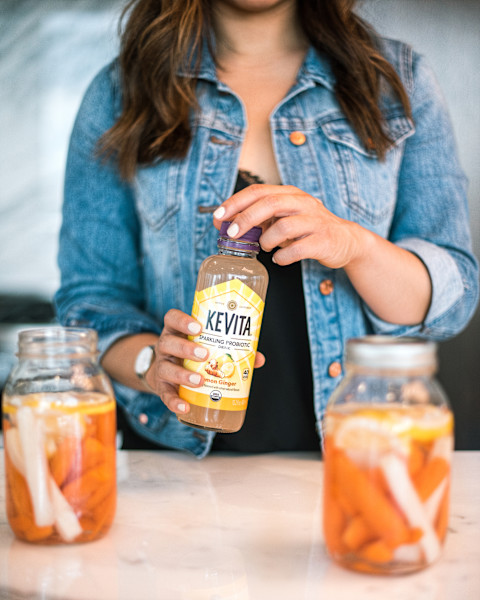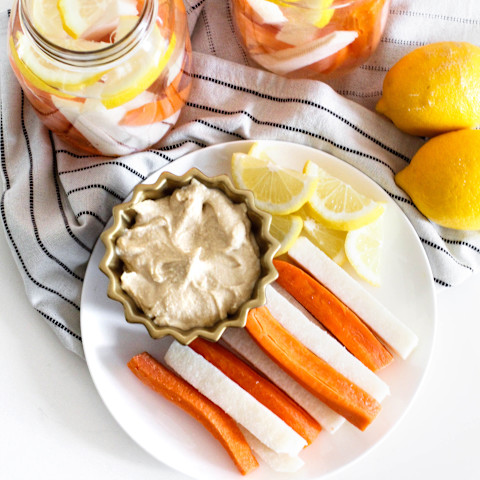How To Ferment Veggies At Home Like A Dietitian

This summer, wellness experts and thought leaders gathered to attend mbg’s fifth annual revitalize for a weekend of forward-thinking talks, movement, and nourishing eats from the biggest names in nutrition. Here’s a recipe inspired by the Fermented Feast hosted by KeVita.
Ever since revitalize 2018, I’ve been more inspired than ever to have an open mind when it comes to the different ways to create new healthy habits beyond our usual routine.
I’ve learned to keep an open mind to new experiences like incorporating moments of stillness and meditation throughout my day to reduce stress (something I’ve never made time for before). It’s been helpful not only from a mental aspect, but from a physical one as well. Stress may have an impact on our digestive state and the way we absorb nutrients. Under stressful situations, our digestion can slow down which can lead to uncomfortable side effects, like bloating and indigestion. Finding ways to manage stress is part of building a routine that helps in reducing digestive issues.
With the increasing research on the gut-brain connection emphasizing the importance of our microbiome, it’s no surprise that gut health is near the top of my priority list when it comes to maintaining healthy habits.
As a dietitian, I’m the first to tell you that our food choices matter—especially in relation to the overall integrity of our gut microbiome. In addition to stress reduction, our food choices play an important role in introducing and maintaining healthy bacteria into our gut for overall health.

Almost two months later, I still find myself thinking about the Fermented Feast dinner with KeVita at revitalize and using the menu as a source of inspiration for new recipes. The dinner showed us all the different ways gut-friendly foods can be incorporated into everyday recipes. I love that it used a variety of fermented foods in creative ways! One of the starters was a fermented pickled vegetable mix with an edamame nori hummus. Tasted as amazing as it sounds, and it inspired me to start experimenting with my own fermented vegetable recipe.
Fermented vegetables are essentially vegetables soaked in a salt brine, so it’s easy and requires minimal ingredients. Under the right temperatures, an acid naturally occurs to ferment the vegetables. Studies have shown that the acid produced from fermentation in fermented foods may help reduce glucose response after a meal. Even though it might sound intimidating at first, the process is really simple and only requires time and a few supplies.
Regardless of whether you decide to leave the vegetables in their whole form or sliced/shredded, just makes sure you’re using a jar big enough so that the vegetables are completely covered in the brine.
You can choose any vegetable you like to ferment, but a few of my favorites are root vegetables: carrots, beets, radishes, and turnips. Root vegetables adds in hearty texture that works great in any fermented vegetable recipe.
My current favorite flavor combination is inspired by one of the probiotic drink flavors I had from KeVita at revitalize this year: the Sparkling Probiotic Drink in Lemon Ginger. When combined, these flavors work great for a tart and spicy kick to any recipe.
Both carrots and jicama are a source of prebiotic fiber which is necessary for the probiotics we introduce into our gut. they may help balance out the gut and help probiotics to work at their best. The good bacteria feeds off the prebiotic fiber from these foods to help maintain the right balance in our microbiome. Once you start fermenting your own vegetables, you’ll find that the combination of vegetables allow for endless possibilities of flavors!
Lemon Ginger Carrot and Jicama Sticks

Ingredients
- 1 lbs jicama sticks
- 1 lbs carrot sticks
- 3 cups water
- 2 whole lemons
- 2-inch piece ginger
- 3 tsp sea salt
Method
- Combine salt and water and stir.
- After salt dissolves, place the carrots, jicama, lemon, and ginger into a jar.
- Pour over salted water to completely cover the jicama and carrots. Make sure the vegetables are full covered in the salt brine.
- Cover the lid with cloth or paper towel and secure with a rubber band.
- Leave in a cool spot, away from direct sunlight for a minimum of one week. The longer it sits, the more “tangy” the vegetables will get. After a week, transfer to the refrigerator for storage.
Disclaimer: The information in this article is the opinion of the author(s) and in no way reflects the policies or positions of KeVita. This is not intended to be a substitute for professional medical or nutrition advice.
